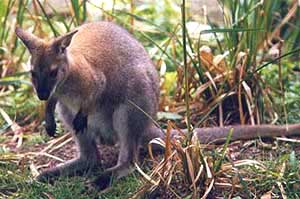Related Research Articles

The order Peramelemorphia includes the bandicoots and bilbies. All members of the order are endemic to Australia-New Guinea and most have the characteristic bandicoot shape: a plump, arch-backed body with a long, delicately tapering snout, very large upright ears, relatively long, thin legs, and a thin tail. Their size varies from about 140 grams up to 4 kilograms, but most species are about one kilogram.

Bandicoots are a group of more than 20 species of small to medium-sized, terrestrial, largely nocturnal marsupial omnivores in the order Peramelemorphia. They are endemic to the Australia–New Guinea region, including the Bismarck Archipelago to the east and Seram and Halmahera to the west.

Thylacinidae is an extinct family of carnivorous, superficially dog-like marsupials from the order Dasyuromorphia. The only species to survive into modern times was the thylacine, which became extinct in 1936.
Yalkaparidon is an extinct genus of Australian marsupials, first described in 1988 and known only from the Oligo-Miocene deposits of Riversleigh, northwestern Queensland, Australia.

The New Guinean long-nosed bandicoots are members of the order Peramelemorphia. They are small to medium-sized marsupial omnivores native to New Guinea.

Perameles is a genus of marsupials of the order Peramelemorphia. They are referred to as long-nosed bandicoots or barred bandicoots.

The marsupial family Peramelidae contains the extant bandicoots. They are found throughout Australia and New Guinea, with at least some species living in every available habitat, from rainforest to desert. Four fossil peramelids are described. One known extinct species of bandicoot, the pig-footed bandicoot, was so different from the other species, it was recently moved into its own family.
Yarala is a genus of fossil mammals that resemble contemporary bandicoots. The superfamily Yaraloidea and family Yaralidae were created following the discovery of the type species Yarala burchfieldi in 1995, on the basis that it lacks synapomorphies that unite all other peramelemorphian taxa.

The Macropodiformes, also known as macropods, are one of the three suborders of the large marsupial order Diprotodontia. They may in fact be nested within one of the suborders, Phalangeriformes. Kangaroos, wallabies and allies, bettongs, potoroos and rat kangaroos are all members of this suborder.
Ganguroo is a genus of fossil macropods found at Riversleigh in Australia, material dating from the Middle to Late Miocene Epoch. The type species of the genus is Ganguroo bilamina, published in 1997. Two recently described species, Ganguroo bites and Ganguroo robustiter, have also been placed in this genus.
Priscakoala is an extinct genus of koala from the Early Miocene of Riversleigh, Australia. It has one species: Priscakoala lucyturnbullae.
This paleomammalogy list records new fossil mammal taxa that were described during the year 2013, as well as notes other significant paleomammalogy discoveries and events which occurred during that year.
Bulungu is an extinct genus of bandicoot-like mammal from Oligo-Miocene deposits of Riversleigh, northwestern Queensland, and the Etadunna Formation, Australia. It was first named by Gurovich et al. (2013) and the type species is Bulungu palara. Two additional species, Bulungu campbelli and Bulungu minkinaensis, were also described in 2013. Bulungu muirheadae is the oldest fossil bandicoot recovered to date. An additional three species Bulungu minkinaensis, Bulungu pinpaensis, and Bulungu westermani were named by Travouillon, Beck & Case (2021) allowing for placement of the genus in the superfamily Yaraloidea.
This paleomammalogy list records new fossil mammal taxa that were described during the year 2010, as well as notes other significant paleomammalogy discoveries and events which occurred during that year.
Cookeroo is a genus of extinct kangaroos from the Late Oligocene and Early Miocene found in fossil deposits from the Riversleigh World Heritage Area, in Australia. The genus includes two species, C. bulwidarri and C. hortusensis.
Hypsiprymnodon karenblackae is a fossil species describing a small marsupial extant in Australia during the Early to Middle Miocene Epoch. The material was collected at the Australian Fossil Mammal Sites (Riversleigh). The taxon was published in 2014, along with several other new species of the genus Hypsiprymnodon, known as musky rat-kangaroos. The morphology of the teeth suggest it existed in a wet rainforest environment, similar to the ecological conditions of the extant species, the musky rat-kangaroo. The type specimen was collected at the Camel Sputum site, classified as a Faunal Zone B (Miocene) deposit at Riversleigh in northwestern Queensland, The epithet is for Dr. Karen Black's contribution to palaeontology in Australia, especially the Riversleigh fossils.

Crash bandicoot is an extinct bandicoot, known from fossils located at the Riversleigh World Heritage Area in northeast Australia.
Liyamayi dayi is a mammal species of the Thylacomyidae family known from fossils located at the Riversleigh World Heritage Area in northeast Australia. The discovery of the specimens was identified as deposited around fifteen million years ago, revising the earliest record of this peramelemorphian lineage from those of species that existed around ten million years later.
Karen H. Black, born about 1970, is a palaeontologist at the University of New South Wales. Black is the leading author on research describing new families, genera and species of fossil mammals. She is interested in understanding faunal change and community structure in order to gain new understandings of past, current and future changes in biodiversity which are driven by climate.
Whollydooleya tomnpatrichorum is a fossil species discovered just beyond the Riversleigh World Heritage Area, an early example of adaptations to hypercarnivory. The dating of the deposit, while uncertain, is associated with material assigned to the genus Ekaltadeta, placing its occurrence in the middle or late Miocene epoch.
References
- ↑ K. J. Travouillon; Y. Gurovich; M. Archer; S. J. Hand; J. Muirhead (2013). "The genus Galadi: three new bandicoots (Marsupialia, Peramelemorphia) from Riversleigh's Miocene deposits, northwestern Queensland, Australia". Journal of Vertebrate Paleontology. 33 (1): 153–168. Bibcode:2013JVPal..33..153T. doi:10.1080/02724634.2012.713416. S2CID 53525712.
- ↑ K.J. Travouillon; Y. Gurovich; R.M.D. Beck; J. Muirhead (2010). "An exceptionally well-preserved short-snouted bandicoot (Marsupialia; Peramelemorphia) from Riversleigh's Oligo-Miocene deposits, northwestern Queensland, Australia". Journal of Vertebrate Paleontology. 30 (5): 1528–1546. Bibcode:2010JVPal..30.1528T. doi:10.1080/02724634.2010.501463. S2CID 86726840.


